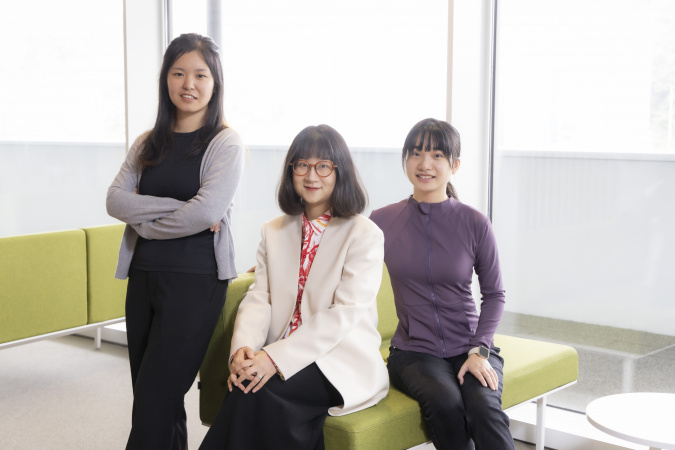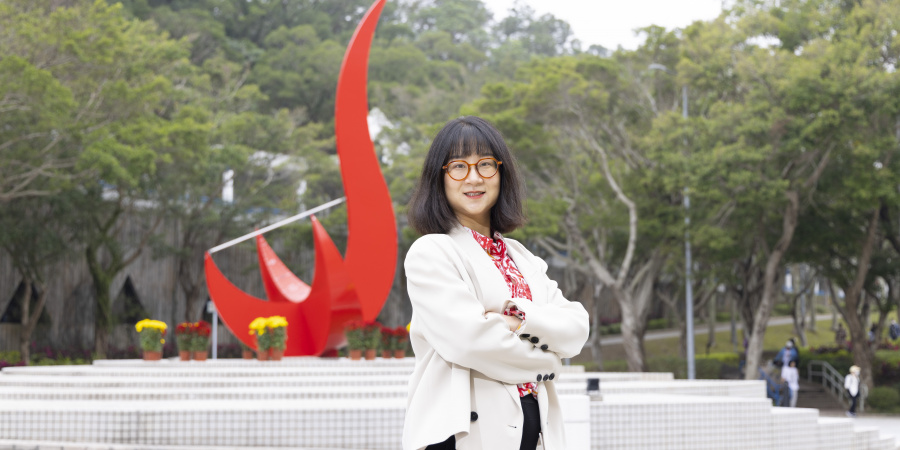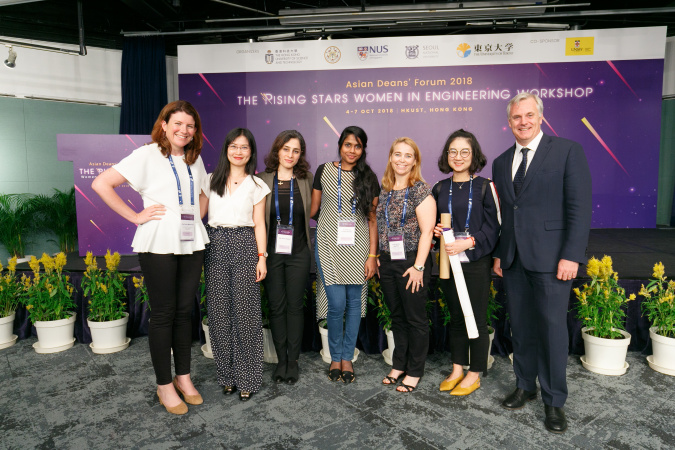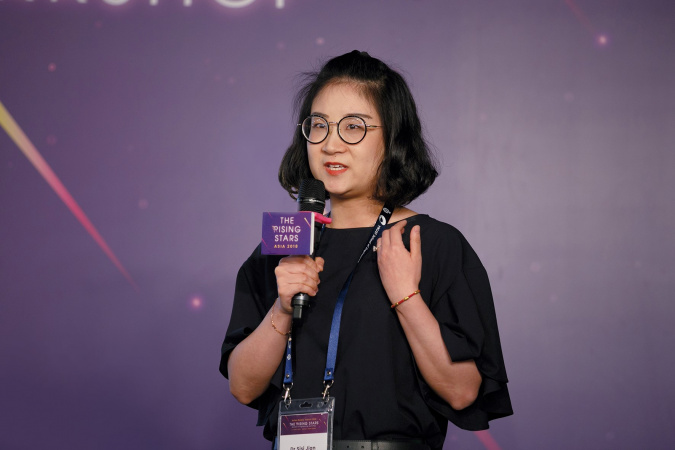Moving People Forward Through Transportation Engineering
Becoming a leading-edge early career faculty member in smart mobility has proved transformative professionally and personally for Prof. JIAN Sisi, a journey she is now encouraging others to try.
It was while Prof. Jian Sisi was a postdoc at the University of New South Wales in Sydney that she was notified of a first-of-its-kind international gathering at HKUST School of Engineering (SENG). Little did she realize that in becoming one of the 50 carefully selected participants at the Asian Deans’ Forum’s Rising Stars Women in Engineering Workshop in October 2018 she was about to undertake a life-changing event.
But definitive it proved. The forum, organized in collaboration with engineering schools at National Taiwan University, National University of Singapore, Seoul National University, The University of Tokyo, and co-sponsored by the University of New South Wales, gathered female engineering postgraduates and researchers from leading global universities and institutions such as Harvard and ETH Zurich to explore an academic career in Asia Pacific. Just five months later, Prof. Jian had moved to Hong Kong to become a faculty member at HKUST.
Choosing academia as a career
Prof. Jian is now celebrating five successful years in SENG’s Department of Civil and Environmental Engineering, renowned for its global leadership in transportation engineering. There, she specializes in smart transportation, a key area that will determine how people move around in the cities of the future and connect with each other across the globe, while nurturing and enthusing the next generation of engineering transportation talents.
“The period when I attended the workshop was my ‘struggle’ period,” Prof. Jian recalled, a time when she was trying to determine whether to stay in academia or go into industry or government. “The workshop was unique as all the keynote speakers were female professors and never in my engineering student life had I seen so many women academics. What’s more, I had a chance to meet them, find out how strong, self-motivated and clear-minded they were. Finding such a lot of women professors who could share their experience and how they developed their careers motivated me to stay in academia.”
Hailing originally from Anhui Province in Mainland China, travel and transportation have been a way of life as well as a career for Prof. Jian. This began with horizon-stretching visits to different locations around the country with her parents – one a geography teacher – during school term breaks. She was also deeply influenced by an aunt who ran a logistics company. Following high school, her interest took her first to undergraduate studies in transportation engineering at Central South University in Changsha – selected for the country’s prestigious Project 211, Project 985 and Double First-Class University Plan and a transportation research heavyweight – and on many self-organized trips around Hunan Province. Always keen on mathematics and solving problems related to optimization, she then ventured to Singapore’s Nanyang Technological University for a master’s in logistics. Later, she went further afield to Australia for her PhD in transport network planning.
Pillar role of mobility in people’s lives
When Prof. Jian tells people she works in transportation engineering, they often ask whether this means she builds bridges or railways. Rather than hardware and infrastructure, she says in response, she is involved in planning. “The field is an interdisciplinary area, sitting between engineering, social science, and business,” she explained.
It is also now a rapidly moving field, making it exciting and impactful to research. “People might think transportation is a highly conventional area, but it’s not,” she said. Fast-evolving technologies, including information technology, automation and electrification, have brought many new avenues of investigation in recent years, she noted. It is also crucial to individuals’ opportunities in life. “Mobility, along with energy and health or medical resources, is one of the foundations of people’s lives,” she said.
Connecting up human behavior and transport system efficiency
While the field is largely divided into human behavior or optimization of transportation systems from the supply side, Prof. Jian is unusual in exploring both, having been supervised for her PhD by two professors, one from each stream.
Seeking to make a difference to people’s lives, her work is usually directed at informing government policy-making, with a focus on mathematical modeling of human behavior and fusing such insights with transportation system models for all-round optimization. Private businesses have their own engineers and other experts who work for them and their particular interests, she said. “I think my research should benefit society.”
One such societal goal might be carbon neutrality and hence a need to understand people’s travel decision-making in order to design policies to induce behavior change. By understanding why people make the decisions they make, the models can then take this into account and measures be designed to “try to influence their decisions in a way we want” as well as maximize efficiency. For example, high parking fees alongside a highly advanced public transport infrastructure, as in Hong Kong, might help discourage driving.
Driving forward social equity
To investigate the two streams and ways to fuse them, Prof. Jian’s SmartMobility Group, employs leading-edge research techniques ranging from linear programming to game theory, experimental economics to machine learning, to bring fresh insights to network optimization, demand modeling for shared mobility systems, and multimodal mobility services such as evolving mobility as a service (MaaS), where transport is available on demand. The research team is also part of the HKUST’s GREAT Smart Cities Institute.
Prof. Jian’s initial focus was shared mobility, such as Uber or ride-sharing, where people don’t use their own car and thus reduce vehicle ownership. However, since the pandemic, she has moved more into fairness in transportation. “I think COVID-19 raised a lot of issues regarding social equity.” In Hong Kong, the government made great efforts to persuade people to take a vaccine, even offering a choice of types and makes. Yet in other locations, there were no vaccines available at all, she pointed out.
The situation also made her consider transportation’s role in such endeavors. It is critical to get vaccines to the right place at the right time. But equity was not a primary consideration of how transportation resources were allocated. And with autonomous vehicles and smart city mobility now on the near horizon, equity needs to be part of how such systems are designed. “If we don’t have equity in mobility services, it will affect people’s opportunities,” Prof. Jian said, not only in terms of healthcare but other essential areas such as education and business activities.
Revving up next-generation transportation designers
Where the dynamic transport explorer is seeking to make a difference is by using her engineering capabilities to quantitatively evaluate equity. “I need to consider human behavior and social science as there are many definitions of equity,” she explained. “People who work in social science have talked about equity for many, many years but they always talk qualitatively… I need to try to build a framework to comprehensively investigate equity in transportation from a quantitative perspective.”
In one current project, supported by Hong Kong Research Grants Council (RGC) funding of almost HK$1 million, Prof. Jian and her research group have been looking at pricing and resource allocation under equity constraints. Another RGC-funded study is exploring revenue sharing and resource allocation for cooperative multimodal transport systems.
In carrying out such work, she is quick to acknowledge the teamwork involved, and the novel ideas and perspectives she gains from students and young researchers. “My students have helped me a lot. We work together to attain our achievements. It’s not me alone.” She is also delighted to see many female students reaching out to inquire about her research team, which has current and graduated women members and others co-supervised through HKUST(GZ), the University’s Nansha campus. “I think female students have a tendency to underestimate themselves, but when they find I have a number of female students, they are willing to contact me.”
Meanwhile, on the teaching front, Prof. Jian is happy with students’ respectful reaction to her as an educator. She views this as part of the positive global change in the engineering learning environment and women’s growing role within it over the past five years, a change she credits to wider societal moves and worldwide campaigns that have helped women speak up, including in Asia. She has also been impressed by HKUST’s Women in Science and Engineering (WISE) group as an effective link between female faculty and students at all levels, with events often organized by undergraduates. “I have attended almost every dinner or sharing event and every time I’ve received many questions from other participants who are very curious about how female professors manage, what difficulties they face, how we dealt with challenges as undergraduates, among others.”
Laying out the road ahead
And just as Prof. Jian benefited so much from the Asian Deans’ Forum’s Rising Stars gathering five years earlier, she has been giving back through the same event. At the workshop held in Tokyo in 2023, this saw her encourage other high-flying female engineering doctoral students and postdocs to choose academia by sharing her SENG early career faculty stories and serving as a mentor. “I believe my experience can help other female students who may be ‘struggling’ as I was before… and I do want to see more women in engineering in academia.”
Equally important, it marked another milestone in her own personal development. “I felt I had now stepped to a stage where I can try to influence people around me and help those junior to me. This was a very important and happy move for me,” she said. And good news for the future of transportation engineering and equitable systems to improve people’s mobility.
Related link:




